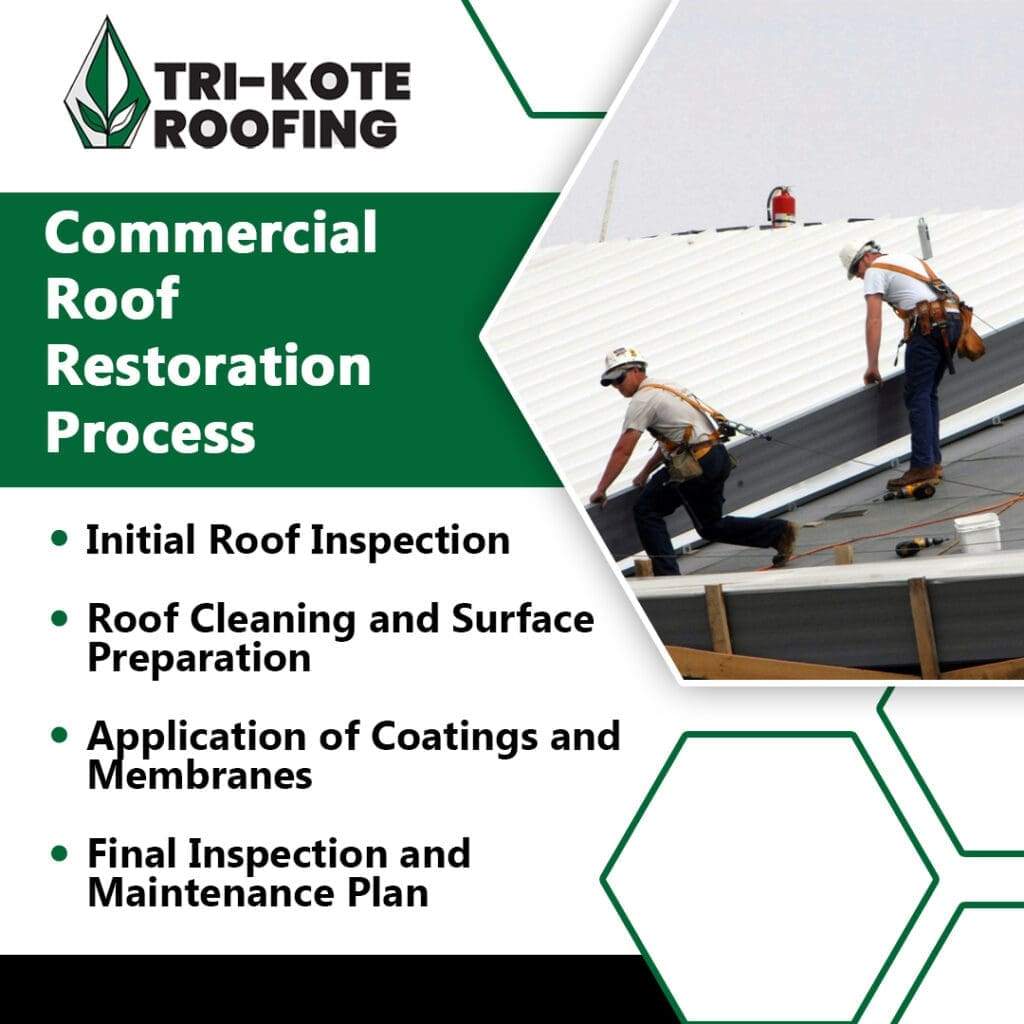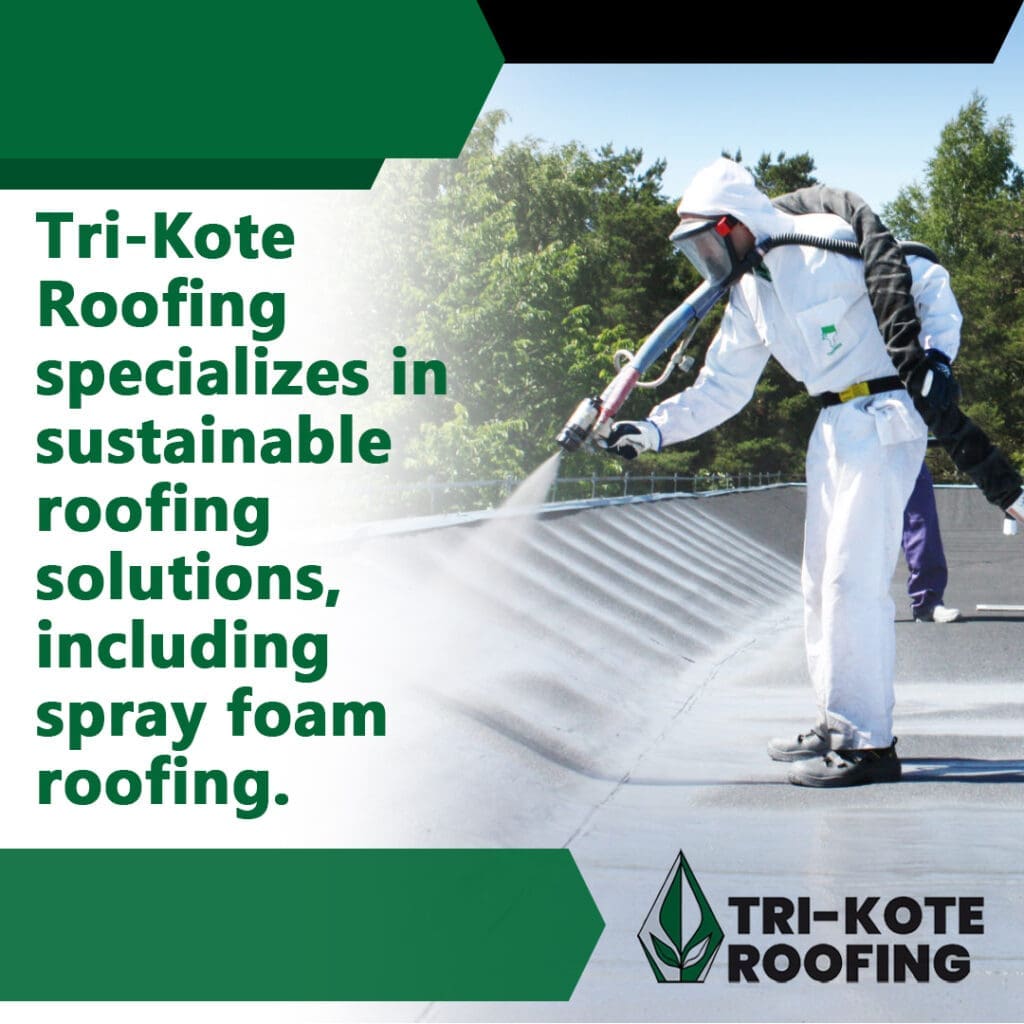Commercial property owners in Bedford, OH, and surrounding areas face significant challenges in maintaining the integrity of their roofs while controlling costs. Aging commercial roofs can lead to water intrusion, energy inefficiency, and costly repairs if not properly maintained. Roof replacement is often expensive and disruptive to business operations. However, commercial roof restoration provides a cost-effective and sustainable alternative that extends the life of an existing roof while enhancing its performance.
Tri-Kote Roofing specializes in commercial roof restoration solutions that address common issues such as leaks, insulation inefficiencies, and structural degradation. With over 20 years of experience, our team is committed to helping businesses protect their investments through high-quality restoration techniques, including energy-efficient spray foam roofing. By choosing restoration over replacement, businesses can minimize downtime, reduce material waste, and improve the overall energy efficiency of their buildings.
This guide outlines the step-by-step process of commercial roof restoration, detailing how businesses can benefit from a professional assessment, thorough surface preparation, and advanced coating applications. Whether your building requires improved insulation, leak prevention, or a long-term maintenance strategy, understanding the restoration process can help you make informed decisions that protect your commercial property and reduce operational costs.
Initial Roof Inspection
An initial roof inspection is necessary for any commercial building. It allows a commercial roofer to assess the roof’s current condition and identify potential issues that may impact the building’s functionality. This step guarantees that the restoration plan is tailored to extend the lifespan and enhance energy efficiency, especially when considering energy-efficient roofing solutions like spray foam roofing.
What Happens During the Inspection?
During the inspection, a commercial roofer evaluates the roof’s surface, structure, and drainage system. Using advanced tools, the roofer detects hidden issues like water penetration or moisture buildup, which could compromise the roof’s performance. By identifying these concerns early, you can avoid costly repairs down the line and better plan for necessary improvements, especially for commercial roof installation projects.
Common Problems Identified in the Inspection
- Leaks: These occur due to cracks, gaps, or worn-out materials in the roofing system. They can lead to considerable damage, especially in commercial buildings with flat roofs or complex designs.
- Structural Damage: This refers to issues with the roof’s support system, including weakened beams or decking, which can lead to collapse or other serious structural problems.
- Wear and Tear: Over time, roofing materials degrade from exposure to weather conditions, including sun, rain, and wind. This wear compromises the roof’s protective qualities, leading to cracks, blistering, or general deterioration.
By having a commercial roofer conduct a thorough inspection, businesses can proactively address these issues, ensuring the roof is prepared for an energy-efficient upgrade like spray foam roofing, which offers long-term durability and enhanced energy savings.
Roof Cleaning and Surface Preparation: Necessary Steps for a Successful Roof Restoration
Roof cleaning and surface preparation are key components in any roof restoration project, especially when considering commercial roof installation. These vital steps ascertain that restoration materials bond effectively, improve the roof’s longevity, and contribute to enhanced energy efficiency, particularly with energy-efficient roofing solutions.

Why is Roof Cleaning Necessary?
Roof cleaning is a critical initial step in the restoration process because it removes dirt, debris, algae, and other contaminants that can hinder the adhesion of restoration materials. If left untreated, these impurities can cause coatings to fail, considerably reducing the roof’s durability and lifespan. This is particularly important for energy-efficient roofing systems, as a clean surface allows for top performance of the reflective coatings designed to reduce energy costs. For example, removing moss and dirt guarantees that the coating or membrane adheres to the roof properly, providing better insulation and energy savings.
What Cleaning Methods Are Used?
Various cleaning methods are employed depending on the condition of the roof and the type of materials involved. The most common method is pressure washing, which uses high-pressure water to remove dirt, moss, and other contaminants. This method is highly effective for tough, durable surfaces. For more delicate surfaces, soft washing is often used. This technique applies low-pressure water combined with special cleaning solutions to safely remove contaminants without damaging the roof. In cases where stubborn debris remains, hand scraping may be necessary to remove the toughest contaminants manually.
Surface Preparation for Coating
Once the roof is clean, surface preparation makes sure that restoration coatings adhere properly. This step is necessary for preventing premature coating failure and guaranteeing that the roof performs well over time. For commercial roof installation or spray foam roofing, surface preparation plays a critical role in the long-term success of the restoration process.
Why Is Surface Preparation Critical?
A smooth, clean, and dry surface is necessary for proper bonding of coatings. Without adequate preparation, coatings may peel, blister, or fail prematurely, requiring costly repairs. When applying coatings to energy-efficient roofing systems, ensuring that the surface is prepared correctly can prevent air or water leaks, increase energy savings, and extend the roof’s lifespan.
What Does Surface Preparation Involve?
Surface preparation typically involves several steps, such as sanding rough spots, patching cracks or damage, and priming the roof to create an even surface. These processes remove imperfections and provide a stable foundation for the final coating, ensuring that the roof is both durable and energy-efficient. Proper surface preparation helps maintain the performance of the restoration materials, making the roof more effective in the long run.
Roof cleaning and surface preparation are indispensable for successful roof restoration, especially when aiming to maximize the benefits of energy-efficient roofing and spray foam roofing systems. These steps not only enhance the roof’s durability but also guarantee better energy performance, making them a critical part of any commercial roofing project.
Application of Coatings or Membranes
The application of coatings or membranes is a critical step in roof restoration, contributing to the roof’s durability and energy efficiency. Using the right coatings improves the roof’s ability to reflect UV rays, reduce energy costs, and protect against water damage. For commercial properties, this is a smart investment that extends the roof’s life, especially when integrated with solutions like energy-efficient roofing.
What Types of Coatings Are Used in Roof Restoration?
In roof restoration projects, various types of coatings are applied based on the roofing system’s requirements. Silicone, acrylic, and polyurethane coatings are popular choices because they offer excellent protection against harsh weather conditions. These coatings provide a seamless barrier that helps preserve the roof, reflecting UV rays to keep buildings cooler and reducing overall energy consumption. They also prevent water from infiltrating the roof, which helps maintain structural integrity.
What Benefits Do These Coatings Offer?
The primary benefit of these coatings is the considerable energy savings they bring to commercial buildings. By reflecting UV rays, coatings reduce the heat absorbed by the roof, lowering the cooling costs. They also prevent the formation of leaks, which could damage the building’s interior. Additionally, the protective layer provided by these coatings contributes to the overall longevity of the roof, ensuring that commercial roof installations continue to serve their purpose for years.
Spray Foam Roofing for Commercial Roofs
What is Spray Foam Roofing?
Spray foam roofing is a seamless, high-performance roofing solution for commercial buildings. This roofing system involves applying a liquid that expands into a solid foam, creating an airtight and waterproof barrier. The foam seamlessly covers the roof, filling gaps and cracks, which considerably reduces the risk of leaks and improves energy efficiency.
Why Use Spray Foam in Roof Restoration?
Spray foam is highly effective for addressing gaps, cracks, and seams in existing roofing systems. Its ability to expand and fill irregularities guarantees a uniform, tight seal, preventing water penetration. Beyond leak prevention, spray foam helps reduce thermal transfer, improving the building’s overall energy efficiency. For energy-efficient roofing, this solution is highly advantageous, providing both short-term protection and long-term savings.
Final Inspection and Maintenance Plan
Once the roof restoration process is complete, it’s important to carry out a final inspection to confirm that all steps have been properly executed. This includes verifying that all coatings and membranes have been evenly applied, ensuring no spots were missed. The final inspection also evaluates the overall quality of the restoration, ensuring that it meets the necessary standards. This step guarantees the roof’s longevity and performance for your commercial property.
What Happens After Roof Restoration?
Following the restoration, a final inspection is conducted to confirm that every phase—from cleaning to the application of energy-efficient roofing materials—has been completed properly. During this inspection, the commercial roofer checks for any overlooked spots or areas that might need additional attention, such as insufficiently coated sections or any structural concerns. If the roof passes this final check, it is fully restored and ready to provide lasting protection for your building.
Why Is a Maintenance Plan Important?
A maintenance plan is important for preserving the restored roof’s integrity. Regular maintenance helps prevent small issues from growing into bigger problems that could require costly repairs. By scheduling periodic checks, the roof’s coating and membrane can be kept in good condition, reducing the risk of leaks or structural damage. If you’ve opted for spray foam roofing, maintaining regular inspections guarantees that the foam layer remains intact and continues to offer excellent thermal insulation and waterproofing, ultimately extending the roof’s lifespan.
How Often Should the Roof Be Inspected?
To maximize the effectiveness of your commercial roof installation, it’s recommended to schedule annual inspections. A commercial roofer will assess the roof for any minor damage, such as small cracks or issues with energy-efficient roofing materials, like silicone or acrylic coatings. Early detection allows for prompt repairs, preventing considerable damage from developing and ensuring your roof’s long-term performance. Regular inspections not only help maintain your roof’s structural integrity but also make sure that your energy-efficient solutions remain effective over time.

The Role of Tri-Kote Roofing in Commercial Roof Restoration
How Does Tri-Kote Roofing Handle Roof Restoration?
At Tri-Kote Roofing, based in Bedford, OH, we specialize in providing top-tier, energy-efficient roofing solutions, including extensive roof restoration services. With more than 20 years of experience in the commercial roofing industry, our team uses advanced materials like spray foam roofing to deliver durable, high-performance roofs that extend the life of your building. We follow a structured, step-by-step restoration process to make sure that your roof is fully restored, addressing all underlying issues and enhancing its energy efficiency.
Why Choose Tri-Kote Roofing for Your Restoration Project?
Choosing Tri-Kote Roofing means you’re investing in a thorough, professional restoration that prioritizes quality and longevity. Our team is dedicated to delivering commercial roof installation and restoration services that not only fix existing problems but also improve your roof’s energy performance. Our solutions, such as spray foam roofing, can reduce energy consumption by offering superior insulation and reflectivity, ultimately leading to considerable savings on your building’s energy costs.
What Makes Tri-Kote Roofing Different?
What sets Tri-Kote Roofing apart is our unwavering commitment to quality, safety, and customer satisfaction. With a focus on using sustainable materials and techniques, we make sure that your restoration project is completed with precision and care. From the initial inspection to the final coating application, we guarantee that skilled professionals handle every step so your restored roof performs at its best for years to come. Whether it’s a minor repair or a complete restoration, Tri-Kote Roofing is your trusted commercial roofer, ready to meet all your roofing needs.
Get Started on Your Roof Restoration with Tri-Kote Roofing Today!
Ready to restore your roof with a solution that enhances energy efficiency and durability? Contact Tri-Kote Roofing, your trusted commercial roofer, and let our experts guide you through the process. Reach out to us at (440) 635-6285 or email andrew@trikoteroofing.com to schedule your roof inspection or get more information on our services. Your building deserves the best—trust Tri-Kote Roofing to provide lasting, energy-efficient roofing solutions!

